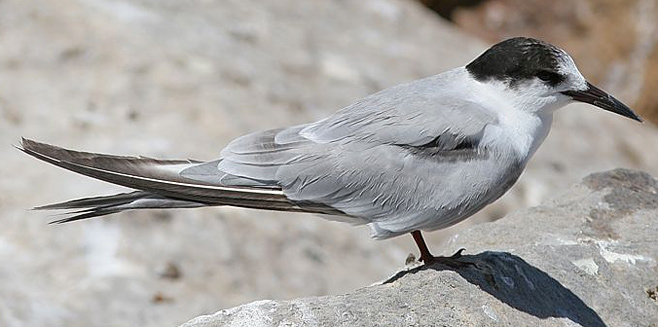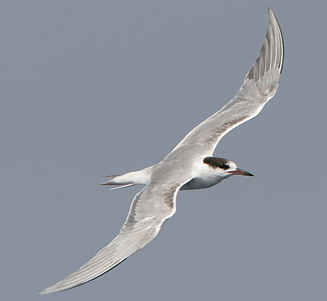|
Sterna hirundo (Common
tern)
Gewone sterretjie [Afrikaans]; Unothenteza (also
applied to Arctic tern) [Xhosa]; Visdiefje [Dutch]; Sterne pierregarin
[French]; Flußseeschwalbe [German]; Gaivina-comum [Portuguese]
Life
> Eukaryotes >
Opisthokonta
> Metazoa (animals) >
Bilateria >
Deuterostomia > Chordata >
Craniata > Vertebrata (vertebrates) > Gnathostomata (jawed
vertebrates) > Teleostomi (teleost fish) > Osteichthyes (bony fish) > Class:
Sarcopterygii (lobe-finned
fish) > Stegocephalia (terrestrial
vertebrates) > Tetrapoda
(four-legged vertebrates) > Reptiliomorpha > Amniota >
Reptilia (reptiles) >
Romeriida > Diapsida > Archosauromorpha > Archosauria >
Dinosauria
(dinosaurs) > Saurischia > Theropoda (bipedal predatory dinosaurs) >
Coelurosauria > Maniraptora > Aves
(birds) > Order: Charadriiformes
> Family: Laridae > Genus: Sterna
 |
|
Common tern in non-breeding plumage, Lambert's Bay, South Africa. [photo
Trevor Hardaker ©] |
 |
 |
|
Common tern in post-breeding moult, pelagic trip
off of Cape Town, South Africa. [photo Trevor Hardaker ©] |
Common tern in non-breeding plumage, pelagic trip
off of Cape Town, South Africa [photo Trevor Hardaker ©] |
Distribution and habitat
Breeds from North America through western Europe to Asia,
heading south in the non-breeding season to the Caribbean, South America,
south-western Europe, South-East Asia, Australia and the entire coastline of
Africa. It is a very common non-breeding migrant to the coast of southern
Africa, occurring in pretty much all coastal habitats.
|
 |
|
Distribution of Common tern in southern Africa,
based on statistical smoothing of the records from first SA Bird Atlas
Project (©
Animal Demography unit, University of
Cape Town; smoothing by Birgit Erni and Francesca Little). Colours range
from dark blue (most common) through to yellow (least common).
See here for the latest distribution
from the SABAP2. |
Predators and parasites
Movements and migrations
Birds originating from the Baltic Sea arrive in
August and September, while the less prolific east European birds
arrive about two months later. Both subspecies leave in the period
from February-May, departing in large flocks in the evening.
Food
Mainly eats small fish and crustaceans, doing most of its
foraging by flying over water while looking downwards; if prey is spotted it
momentarily hovers before plunge-diving to catch the animal.
Threats
Not threatened, in fact it is the most widespread and
second most abundant tern in the world, although its numbers have
decreased at many breeding sites and its range is contracting.
References
-
Hockey PAR, Dean WRJ and Ryan PG 2005. Roberts
- Birds of southern Africa, VIIth ed. The Trustees of the John Voelcker
Bird Book Fund, Cape Town.
|
